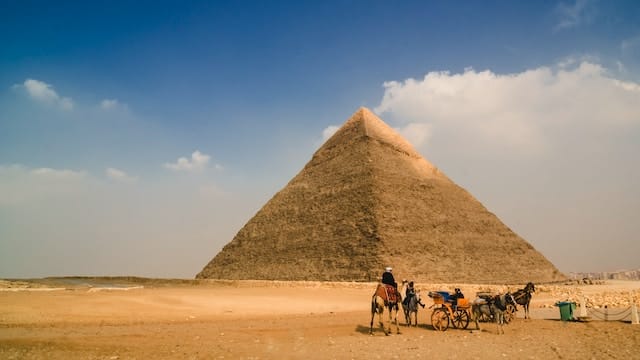The Pyramids of Giza are among the most famous and recognizable ancient structures in the world. Located on the outskirts of Cairo, Egypt, the pyramids have been a marvel of human engineering and architecture for thousands of years. With the largest pyramid, the Pyramid of Khufu, standing at a towering height of 147 meters, the Pyramids of Giza continue to attract millions of visitors every year, who are eager to experience the wonder of these iconic structures.
History of the Pyramids of Giza
The Pyramids of Giza were built over 4,500 years ago during the reigns of the Pharaohs Khufu, Khafre, and Menkaure. The construction of these pyramids was a monumental feat that involved thousands of workers and took over 20 years to complete. The Pyramids of Giza were built as tombs for these three Pharaohs and their queens, and were meant to serve as a final resting place for their bodies, as well as a symbol of their power and wealth.

The largest and most famous pyramid is the Pyramid of Khufu, also known as the Great Pyramid. This pyramid is the oldest and largest of the three pyramids, and it is estimated to have taken over 20 years to construct, using an estimated 2.3 million stone blocks, each weighing an average of 2.5 tons. It is believed that the pyramid was originally covered in white limestone, which has since been stripped away, leaving the rough, weathered surface visible today.
The Pyramid of Khafre, the second largest of the Giza pyramids, was constructed under the patronage of Khafre, the son of Khufu. Though marginally smaller than the Great Pyramid, it creates the impression of being taller as it is situated on an elevated plateau. The pyramid’s upper section is particularly noteworthy as it retains a smooth limestone cladding that has been preserved over the ages.
Constructed by Menkaure, the grandson of Khufu, the Pyramid of Menkaure is the smallest of the three pyramids. One distinctive feature of this pyramid is the presence of a temple complex that includes a mortuary temple, valley temple, and causeway, a unique aspect not found in the other two pyramids.
Visiting the Pyramids of Giza
A visit to the Pyramids of Giza is an unforgettable experience that evokes a sense of awe and wonder. As one approaches the pyramids, their colossal size and scale are truly astounding. Positioned on a desert plateau, the surrounding landscape is dotted with ancient ruins and tombs.
When planning a visit to the Pyramids of Giza, it is highly recommended to engage the services of a knowledgeable guide. A guide can offer valuable insights into the history and significance of these awe-inspiring structures, and help navigate through the complex, pointing out various temples, tombs, and other structures. With the guidance of a qualified expert, visitors can gain a deeper appreciation for the Pyramids of Giza and the ancient civilization that created them.
One of the most popular activities when visiting the Pyramids of Giza is to climb to the top of the Great Pyramid. While this is not for the faint of heart, it is a truly unforgettable experience that offers unparalleled views of the surrounding desert landscape. It is important to note, however, that climbing to the top of the pyramid is not officially sanctioned, and visitors do so at their own risk.
For those seeking a unique experience at the Pyramids of Giza, taking a camel ride around the complex is a popular activity. This allows visitors to enjoy the desert scenery while also getting up close to the pyramids. For a more relaxed pace, horse-drawn carriage rides are also available, offering a leisurely way to explore the area.
The Pyramids of Giza continue to inspire and amaze visitors from all over the world with their timeless beauty and historic significance. The complex is a testament to the ingenuity and skill of the ancient Egyptians, and serves as a reminder of their remarkable achievements.
Pyramids of Giza and Pyramids of Khufu
The Pyramids of Giza, while often grouped together, each possess distinct features and historical significance. The largest and oldest of the three, the Pyramid of Khufu, also known as the Great Pyramid, is particularly noteworthy. Estimated to have taken over two decades to build, it is composed of roughly 2.3 million stone blocks, each weighing an average of 2.5 tons. The pyramid’s exterior was originally adorned with white limestone, which has since been removed, revealing the weathered surface visible today.
Constructed by Khafre, the son of Khufu, the Pyramid of Khafre is the second largest of the three pyramids at Giza. Although slightly smaller than the Great Pyramid, its position on a higher plateau makes it appear taller. Moreover, the pyramid’s upper portion features a layer of smooth limestone that remains intact to this day.
The Pyramid of Menkaure, the smallest of the three, was built by Menkaure, the grandson of Khufu. This pyramid is unique in that it is the only one of the three to have a temple complex attached to it, which includes a mortuary temple, a valley temple, and a causeway.
Conclusion
In conclusion, the Pyramids of Giza are an incredible testament to the ancient Egyptians’ engineering and architectural prowess. These majestic structures have stood the test of time, and continue to inspire and awe visitors from around the world. While visiting the pyramids, it is important to hire a knowledgeable guide who can provide you with a deeper understanding of their history and significance. Climbing to the top of the Great Pyramid and taking a camel ride around the complex are two popular activities that provide unique perspectives on the pyramids. Overall, visiting the Pyramids of Giza is an unforgettable experience that offers a glimpse into the incredible achievements of one of the world’s most fascinating ancient civilizations.






